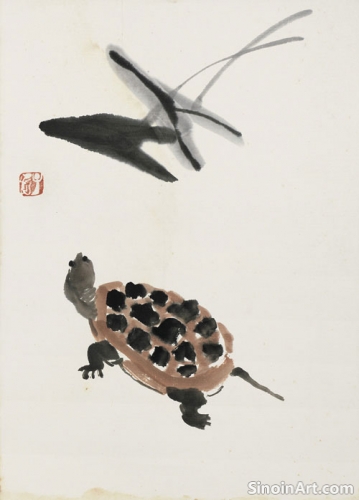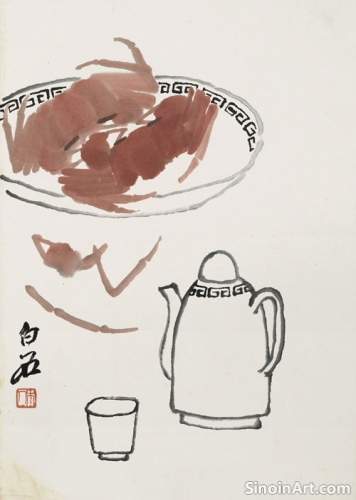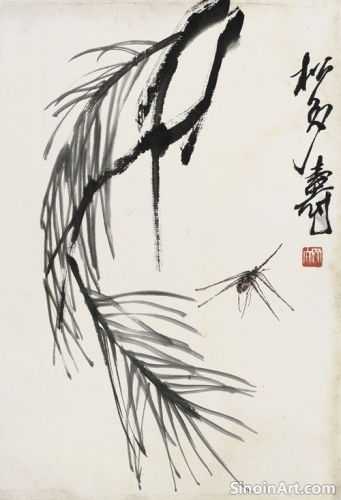The Role of Calligraphy in Xieyi Painting
|
The profound connection between Chinese calligraphy and Xieyi painting is central to understanding the art form. Both disciplines share the same tools - the brush, ink, paper, and inkstone - and rely on similar techniques. In fact, calligraphy is often viewed as the foundation upon which Xieyi painting is built. The calligraphic nature of brushwork is essential to the visual impact of these paintings.  The principles of calligraphy, such as balance, rhythm, and flow, directly translate into the way an artist wields the brush in Xieyi painting. A skilled calligrapher understands how to manipulate the brush to create lines that are not only visually appealing but also imbued with energy and intention. This mastery of brush control is essential for any Xieyi painter. The movement and variations of pressure seen in calligraphic strokes are adopted directly into the painting process.  Each brushstroke in Xieyi painting is imbued with the same spirit and intention as a character in calligraphy. The artist strives for "bone strength" in their lines, which refers to the inner strength and vitality conveyed through the brushstroke. This strength is not about physical force, but about the focused intention and dynamic energy of the artist. This principle of ‘bone’ strength links both disciplines.  The "three perfections" – poetry, calligraphy, and painting – are often seen together in traditional Chinese art. Literati painters were typically also skilled calligraphers and poets, allowing them to integrate these art forms into a harmonious whole. Calligraphy might appear on the artwork itself, adding depth to the visual imagery and revealing more of the artist’s creative thinking. The interplay between calligraphy and painting is not just about shared techniques; it also reflects a shared aesthetic sensibility. Both forms emphasize the importance of spontaneity, the expression of personal feeling, and a deep connection to the natural world. The calligraphic quality in Xieyi brushwork elevates the artistic expression far beyond mere representation. This connection represents a fundamental part of Chinese aesthetics. |
Tag : Calligraphy and painting, Chinese brushwork, Three Perfections, bone strength, literati painting
Related information
- Xieyi Painting and the Influence of Nature
- Xieyi Painting and the Concept of "Shu Xing"
- The Future of Xieyi: Innovation and Tradition
- Xieyi Painting and the Concept of "Jing Jie"
- Xieyi Painting and the Depiction of Landscapes
Nature serves as the primary inspiration for Xieyi painting, influencing subject matter, aesthetic principles, and the pursuit of qi. Artists aim to capture the essential spirit and dynamism of the natural world, fostering a harmonious relationship with it through their artistic practice.
"Shu Xing" (calligraphic nature) is a core concept in Xieyi painting, emphasizing how the principles and techniques of calligraphy influence its brushwork, structure, and expressive qualities, reflecting the shared tools, values, and emphasis on balance, rhythm, and a sense of life force.
The future of Xieyi painting balances innovation and tradition, with artists exploring new materials and technologies while honoring core principles, and its global reach ensures a continued cross-cultural exchange and appreciation of its power and expressiveness, allowing it to continue to adapt and resonate through the generations.
"Jing Jie" (realm) in Xieyi refers to the artist's pursuit of spiritual enlightenment, transcending technical skill to achieve a deeper understanding of themselves, their subject, and the universe, emphasizing intuition, spontaneity, and interconnectedness as they strive for artistic and spiritual transformation.
Xieyi landscapes (shānshuǐ) emphasize grandeur, depth, and qi, using negative space and suggestive brushstrokes to capture the essence, atmosphere, and inner vitality of the natural world, and expressing the artist’s connection to nature and understanding of the Tao.